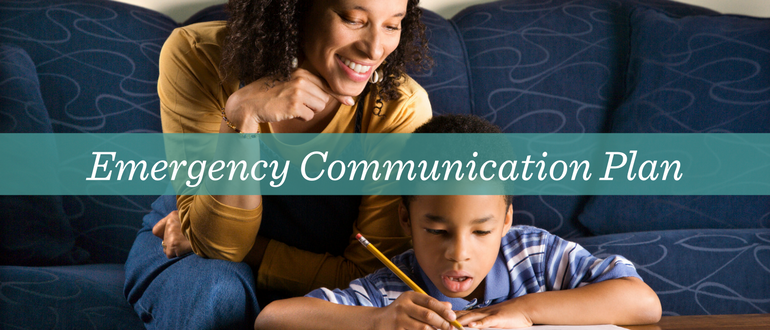A disaster can happen without any notice which is why it’s important all members of your household are prepared for the unexpected. Plan together in advance so that everyone in the household understands where to go during a different type of disaster such as a hurricane, tornado, or wildfire. A storm could take down communication towers rendering cell phones and computers useless. Electricity can be out for days or weeks. Planning can help all family members stay safe and in communication, even if you aren’t together. Follow these three steps when creating your household communication plan.
- Collect Information
Set up emergency meeting places in your home, neighborhood, community, and outside of your town. This is helpful in the event you are all out and cannot get back to your home. This could be a tree in your neighborhood, a friend’s home, or the community library.
Collect all paper copies of contact information into one document and include information such as phone numbers and emails of medical facilities, schools, or the offices of the people in your lives. Store your homeowners’ coverage in an easily accessible spot along with all other important documents such as passports and medical records. Use this time to look over your homeowners insurance policy and add any extra coverage you may need.
If a disaster strikes while you are at work or your children are at school, know the emergency response plans for each location. Inform your children who would pick them up in the event of an emergency and how to follow directions from a teacher. Have your phone or computer set up for alerts while at work so you don’t miss incoming bad weather alerts at the office.
Another way to ensure communication during an emergency is to have an out-of-town contact. This person can be the main contact for everyone in case local phone lines go down. Share their contact information with each member of your family and tell the contact who they should expect a call or text from in the event of an emergency.
- Share information
Now that you have gathered all information, it’s time to share it. Make copies for each family member and post one in a central area of your home, like the refrigerator. Show children where the safe space is in your home.
Provide the family with wallet-sized cards with the address of the meeting place and phone numbers. Make your own emergency communication plan wallet card here! A wallet-sized card is perfect to take on-the-go.
The list of contacts for each friend and family member should be in everyone’s phone with at least one of the contacts under “In Case of Emergency.” In an emergency, a text message may get through before a phone call because it requires less bandwidth than a phone call.
- Practice
Once you have your emergency plan and your friends and family members have all the necessary contact information, it’s time to practice. Challenge each other on reciting phone numbers and addresses by memory in case anyone is separated from their phone or emergency contact list.
Text or call each number in your emergency contact list to make sure you have the number properly written down. Practice texting in a group chat and discuss which information will be sent by chat. Keeping the messages short is more efficient.
Practicing while everyone is in different locations can test your family’s ability to make it to meet-up spots and catch any flaws in the plan to allow you to adjust accordingly. Walk the family through the evacuation plan, what to grab quickly on their way out, and what to leave behind.
Run a mock disaster drill in your home; watch to see if your emergency kit is in an accessible place and if everyone made it to the safe space quickly.
After you practice, talk about how it went, where you can improve, and what worked. Always keep the most updated information including any new phone numbers or addresses.
Learn more learn more about emergency communication plans and how to keep your family safe.
